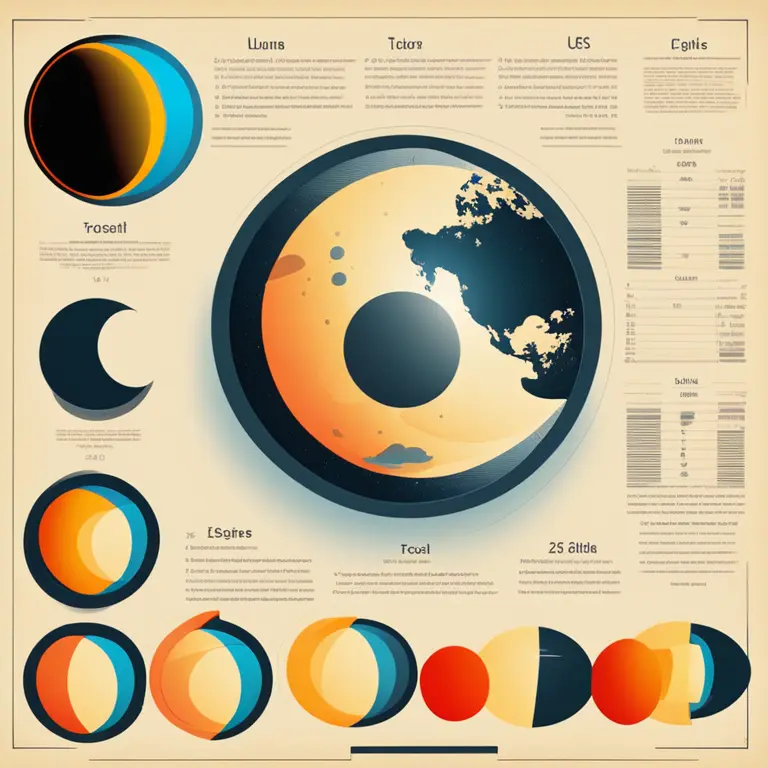
Lunar Eclipse Phases & Meanings
Discover the significance and timings of lunar eclipse phases and their astrological impact.
article by Priya Deshmukh
Lunar Eclipse Basics
An eclipse is a cosmic event that has fascinated humankind for millennia, and the lunar eclipse is no exception. Often steeped in mystery, these occurrences happen when the Earth casts its shadow on the Moon. This event is only possible when the Moon is full, a monthly phase known as the Full Moon, when the lunar face is fully illuminated by the Sun's rays. A lunar eclipse can vary in duration and visibility, depending on several factors such as the alignment of the Sun, Earth, and Moon, and the specific positions of these celestial bodies in space.

Types of Lunar Eclipses
There are three types of lunar eclipses: total, partial, and penumbral. A total lunar eclipse is a dramatic spectacle, with the Moon passing through Earth's umbra, the darkest part of its shadow. During a partial lunar eclipse, only a portion of the Moon enters the umbra, while the rest remains lit. The penumbral eclipse is the most subtle, where the Moon moves through the penumbra, the lighter outer shadow, and often goes unnoticed by casual observers due to the slight dimming effect it has on the lunar surface.

The Astrological Significance
Astrologically, lunar eclipses are considered potent times for release and transformation. Eclipses follow the Saros cycle, an 18-year period after which similar eclipses occur. Observing the patterns that unfold over these cycles can be revelatory. Eclipses in 2024 and beyond will continue to invoke themes of change, urging individuals to let go of the past and embrace their personal growth. Astrologers often advise caution around eclipse periods, suggesting that decisions made during these times carry the weight of destiny more so than at other times.

Watching the Lunar Phases
Monitoring the moon phase during an eclipse provides clues about the nature of the event and its duration. The initial and final phases of an eclipse may be scarcely noticed, as they occur when the Moon moves through the penumbra. The umbral phase, which is when the Moon is completely or partially engulfed by Earth's umbra, marks the main event and is the most visually and energetically significant part of the eclipse. This can affect the tides, human emotions, and the subtle energies around us.
Eclipse Timings and Horoscope Forecasts
Exact timings for eclipses can be calculated decades in advance. Astrologically speaking, each lunar eclipse is distinctive, with its characteristics influenced by the zodiac sign in which it occurs. For example, an eclipse in a water sign can heighten emotional sensitivity, while one in an earth sign might bring attention to practical matters. The upcoming eclipses in 2024 will carry unique energies that can be interpreted through personal and collective horoscopes, offering insights into how they might influence our lives.
Embracing Ecliptic Changes
Ecliptic events are opportunities to embrace change and renew commitments to personal growth. They challenge us to evolve and push the boundaries of our comfort zones. As we witness the Moon's phases during an eclipse, we are reminded of the cyclical nature of change and the recurring opportunities to start anew. Although ominous at times, eclipses serve as celestial signposts, guiding us through life's transitions and illuminating the path forward.
Published: 1/19/2024
Modified: 1/19/2024
More predictions
Come back here soon to learn more about yourself and your future


How Moon Phase Influences on Relationships?
Discover how the lunar cycle can impact your connection with your boyfriend and what each phase may hold for your love life.


Moon Phases & Zodiac Connections
Delve into the mystical entwinement of the lunar cycle and zodiac signs and their collective impact on human ebbs and flows.


Moon Phases and Menstrual Cycles: Celestial Rhythms
Discover the fascinating connection between the lunar cycle and women's menstrual cycles, and how moon phases may influence physical and emotional health.